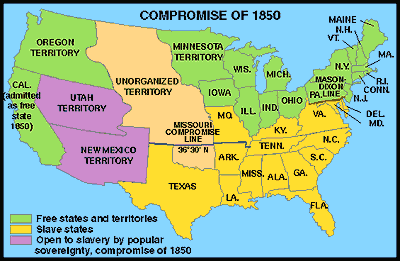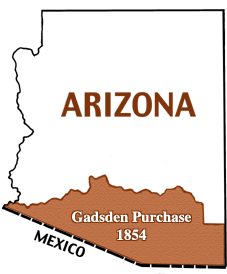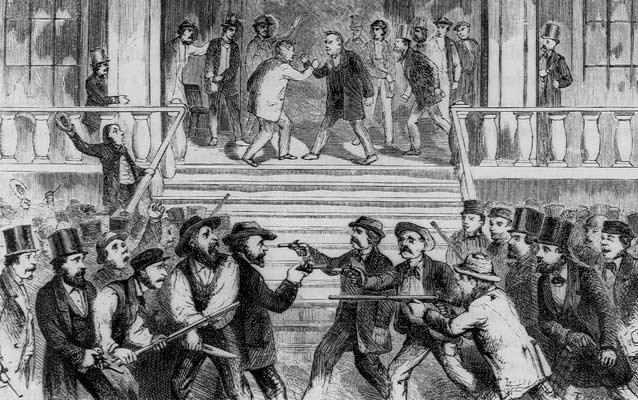This past week in history class, we have been learning about the buffalo soldiers. Buffalo soldiers were African-American Union soldiers after the Civil War. Their responsibilities were to clear out Native Americans and their settlements in the western United States wherever the American government planned on creating settlements. The essential question we were looking to answer was whether federal policies towards Native Americans and buffalo soldiers were intentionally discriminatory or well intentioned.
The American government created several policies that took effect against Native Americans and buffalo soldiers. The Dawes Act of 1887 is one such example. The Dawes Act was "an act to provide for the allotment of lands in severalty to Indians on the various reservations, and to extend the protection of the laws of the United States and the Territories over the Indians, and for other purposes". This federal act was not fair to Native Americans whatsoever. It severely decreased the Native Americans' rightfully earned land, and was an act of federal greed for land. According to Helen Hunt Jackson's A Century of Dishonor, There was no single Native American out of the approximated 250-300 thousand that was not affected by the government's policies concerning the ownership of previous Native American land. For this reason, these policies should be considered intentionally discriminatory towards Native Americans. The very fact that Buffalo Soldiers were sent away to the west, essentially a no-man's-land, proves the intentionally discriminatory actions the government had taken against Buffalo Soldiers.
The policies put out by the American government concerning Buffalo Soldiers and Native Americans especially were intentionally discriminatory towards these people. There was no way that these policies could have been well-intentioned or looking to the benefit of America.
Thomas Gray's History Blog
Monday, June 15, 2015
Thursday, June 4, 2015
The Frienemies of the United States
This week in history class, we have been studying the impact that monopolistic leaders such as Andrew Carnegie and John Rockefeller had on the United States. The essential question we are aiming to answer is how did the actions of monopolistic leaders, such as John Rockefeller and Andrew Carnegie, affect the common worker? A monopoly is defined as when a single corporation controls the entirety of the manufacturing and distribution of a product in a certain region. In order to answer the essential question, we watched videos about Rockefeller and Carnegie. As we were watching, we divided into groups and each group took notes on a certain topic within the videos, such as key terms, main ideas, and key events.
Monopolistic leaders essentially had a love-hate relationship with America. As they were in control of the entirety of the manufacturing and distribution of a product, much of society viewed monopolistic leaders as greedy and driven by money. However, these ideas were not too out of place. The actions of monopolistic leaders had a generally negative effect on the common worker. Many monopolistic leaders treated their workers poorly. Andrew Carnegie himself put a stop to an iron and steel workers’ union utilizing the military, destroying Carnegie’s public reputation. He also used a nationwide financial depression to his advantage to acquire land to connect the steel producing center to the northwest water routes. Rockefeller was believed to be motivated by greed. He raised and lowered his prices in order to buy out his competition, and was thought to be using illegal business tactics to gain his vast amount of money.
Monopolies prove to be not at all beneficial to the common worker in these cases. Perhaps they make things simpler for the consumer, however for the common worker, monopolies prove to be potentially dangerous and not very financially beneficial. The actions of monopolistic leaders had a generally negative effect on the common worker.
Thursday, April 30, 2015
Freedom from Above and Below
Lately in history class, we have been discussing the terms "freedom from above" and "freedom from below", and how these terms were used in the Civil War. Freedom from above is the act of providing equality to people that are of a lower social class than those who are giving it to them. Freedom from below is defined as the act of people in a lower social class using their mass in numbers to overthrow the fewer people in higher social classes to gain equality. In class, we analyzed two documents, each displaying freedom from either above or below. Using these documents, we then tried to figure out who "gave" freedom to enslaved Americans, whether this freedom came from above or below, and how much Abraham Lincoln's actions were influenced by the actions of enslaved Americans.
The first document we analyzed was a work of art depicting Abraham Lincoln seemingly giving freedom to a slave who is kissing his hand and kneeling on the ground. This image depicts freedom from above, as Lincoln was of a higher social class and was seemingly freeing the slave. Freedom came from above in the Civil War for the slaves in that because they were essentially the lowest class in society, freedom from above came from any whites who were willing to help them to freedom.
Freedom from below was very present throughout the Civil War. The second document we analyzed was a picture depicting a mass of slaves walking off of a farm and past a Union camp. This is an example of freedom from below in that the slaves, who are essentially the bottom of the social pyramid, are using their power in numbers to overpower their fewer masters and get out of their current position.
Today, it is harder to tell whether change comes from above or below. It seems to be pretty evenly distributed. For example, after the recent police brutality in New York, the NYPD retrained their officers, however there has been little change nationally concerning the issue, and it does not seem to be stopping anytime soon. The fact that things like this sometimes go unnoticed and sometimes even without acknowledgement from the government is a great hinderance to America and it must change soon, because if the government isn't willing to acknowledge it's faults and institute change from above, we must resort to change from below, which is not always the safest route to take.Friday, April 10, 2015
I Went Looking for Fights! 20 To Be Exact.
Last week in history class, we did a Civil War scavenger hunt. Each student was assigned a battle to learn about, and we each made our own Google Doc that others can view. The Google Docs included the battles' location, date, victor, and theater (east, west, or naval). We then created signs with a QR code linking to the document, a link to the document, and the location of the next battle. We then put the signs in any area of the school of our choosing for our classmates to look for, making a total of 20 battles for the class to look for around the school. We then carried out the scavenger hunt, and when everyone had gotten all the information for all of the battles, we regrouped with the class and used an app called Padlet to determine which side in the Civil War performed the best in each theater. There were two essential questions for this activity. First, who was the ultimate victor in each of the theaters of war: East, West, Naval? Second, what are some commonalities you can identify in the reasons for the results of the battles?
In the east theater, the Confederacy dominated the Union. For example, in the battles of Fredericksburg and Second Manassas the Confederacy had access to heavy artillery and almost invulnerable positions on the battlefield, and therefore were able to win more easily. However, in the western theater, the Union was more dominant over the Confederacy. For example, at the battle of Chattanooga, the Confederate army was overwhelmingly outnumbered. Troops also suffered from poor communication and pressure from their leaders. The Union won most of the battles in the Naval Theater, such as the Battles of Baton Rouge and Vicksburg. They succeeded because they used both the land and sea to their advantage, gaining a positional advantage over the Confederate troops. The Union seemed to generally have much greater tactical skill than the Confederacy. For example, the Union utilized both land and sea to their advantage more so than the Confederacy in such battles as Baton Rouge and Vicksburg. They also used the tactic of surrounding the enemy until they were forced to surrender, such as in the battles of Shiloh and Fort Donelson.
After doing this activity, I know a lot more about not only the Civil War itself, but the tactics and advantages each side used in the war. It is very important to not only look at who has won the war, but also who has won each battle and how they did it, so that we can learn from them.Thursday, March 19, 2015
The Election of 1860
For the past week in history class we have been looking into the Election of 1860 and asking ourselves how the results of this election were representative of the country's deep divisions over slavery. To answer this, we did several activities that answered the question. First, we looked at a map of the results of the Election of 1860. This map showed the major division between the north and south on whether slavery should continue in the U.S. We then viewed several primary source images and took notes on how they help tell the story of the Election of 1860 and secession. Finally, we used these notes to create a storyboard video to help answer our essential question of how the results of the Election of 1860 were representative of the country's deep divisions over slavery.
Thursday, March 12, 2015
The Statistics and Strategies of the Civil War
After looking into the factors building up to the Civil War, our history class now moves into the war itself. To thoroughly analyze the war, we have looked into the statistics and strategies used by both the north and the south in their attempts to win the war. After learning this information, we created info graphics to document these statistics.
Thursday, March 5, 2015
The Elephant That Caused the Civil War
Lately in history class we have been looking into the causes of the civil war. Slavery was one of the most enormous problems between the north and the south, and our job was to try and answer the question of why slavery was the “elephant in the room” for American politics in the early 19th century. In order to answer this question, we analyzed several aspects of the growing ignorance of the problem of slavery in the early 19th century and made a timeline of these events. These pieces of proof were the Compromise of 1850, the Gadsden Purchase, the Kansas-Nebraska Act, “Bleeding Kansas”, The Dred Scott Decision, the Lincoln-Douglas debates, and John Brown’s Raid. I will be using proof from the Compromise of 1850, the Gadsden Purchase, the Kansas-Nebraska Act, and “Bleeding Kansas” to answer the essential question.

 The most pertinent factor to slavery being the elephant in the room for U.S. politics in the early 19th century is the fact that unorganized territory would be made into states, and their state of being either free or supportive of slavery would be decided upon population of these states. In this way, more slave owners would be attracted to this land for the chance to extend their property and gain wealth in doing so, therefore subtly supporting slavery in this matter, while still giving non slavery a say. Also in the Compromise of 1850, the slave trade was abolished in Colombia, Washington however slavery itself was not abolished. Citizens in the U.S. were also required to assist in the recovery of slaves. This attempt to please both supporters and non supporters of slavery further proves that slavery was the elephant in the room for American politics in the early 19th century. The US paid $15 million for all of Nevada, California, Utah, and much of Arizona and New Mexico in the Treaty of Guadalupe Hidalgo. Concerning the Gadsden Purchase, the US paid $10 million for a much smaller strip of land known as the Gadsden Purchase only 5 years later. The reason for the huge price difference per square mile was that the U.S. planned to use the purchased land for a transcontinental railroad. This action supported pro slavery advocates because that land would eventually be settled by, most likely, wealthy slave owners in hopes of expanding their land and money. The Kansas-Nebraska Act did just this. The Compromise of 1850 is essentially overturned in the creation of this act. Both slave owners and anti slavery advocates were happy with this. As a result of this, anti and pro slavery settlers swarm Kansas and set up 2 capitals, 1 for pro slavery and 1 for anti slavery. The anti slavery capital was burned down. John brown, a heavily anti slavery advocate, went to the pro slavery capital and killed many people. This chaos was known as “Bleeding Kansas”. This assisted pro slavery advocates because John Brown’s merciless killing gave the anti slavery advocates a bad reputation. This violence concerning slavery further proves that slavery was the elephant in the room for politics in the early 19th century.
The most pertinent factor to slavery being the elephant in the room for U.S. politics in the early 19th century is the fact that unorganized territory would be made into states, and their state of being either free or supportive of slavery would be decided upon population of these states. In this way, more slave owners would be attracted to this land for the chance to extend their property and gain wealth in doing so, therefore subtly supporting slavery in this matter, while still giving non slavery a say. Also in the Compromise of 1850, the slave trade was abolished in Colombia, Washington however slavery itself was not abolished. Citizens in the U.S. were also required to assist in the recovery of slaves. This attempt to please both supporters and non supporters of slavery further proves that slavery was the elephant in the room for American politics in the early 19th century. The US paid $15 million for all of Nevada, California, Utah, and much of Arizona and New Mexico in the Treaty of Guadalupe Hidalgo. Concerning the Gadsden Purchase, the US paid $10 million for a much smaller strip of land known as the Gadsden Purchase only 5 years later. The reason for the huge price difference per square mile was that the U.S. planned to use the purchased land for a transcontinental railroad. This action supported pro slavery advocates because that land would eventually be settled by, most likely, wealthy slave owners in hopes of expanding their land and money. The Kansas-Nebraska Act did just this. The Compromise of 1850 is essentially overturned in the creation of this act. Both slave owners and anti slavery advocates were happy with this. As a result of this, anti and pro slavery settlers swarm Kansas and set up 2 capitals, 1 for pro slavery and 1 for anti slavery. The anti slavery capital was burned down. John brown, a heavily anti slavery advocate, went to the pro slavery capital and killed many people. This chaos was known as “Bleeding Kansas”. This assisted pro slavery advocates because John Brown’s merciless killing gave the anti slavery advocates a bad reputation. This violence concerning slavery further proves that slavery was the elephant in the room for politics in the early 19th century.
Overall, the growing problem of slavery took hold of the country and proved to be an even bigger problem than people had imagined. Politicians’ brushing it off and pretending it wasn't a problem only proved to worsen the problem, ultimately resulting in the deadliest war in America’s history, the Civil War.
Sources:
http://www.ushistory.org/us/30d.asp
http://cowpuncher.library.arizona.edu/history.htm
http://georgiainfo.galileo.usg.edu/gastudiesimages/Kansas-Nebraska%20Act%201.htm
http://www.nps.gov/fosc/learn/education/classrooms/bklesson.htm
Subscribe to:
Posts (Atom)



